Ragamala paintings
Ragamala paintings are a form of Indian miniature painting, a set of illustrative paintings of the Ragamala or "Garland of Ragas", depicting variations of the Indian musical modes called ragas. They stand as a classical example of the amalgamation of art, poetry and classical music in medieval India.
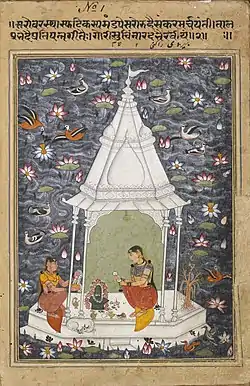
Ragamala paintings were created in most schools of Indian painting, starting in the 16th and 17th centuries, and are today named accordingly as Pahari Ragamala, Rajasthan or Rajput Ragamala, Deccan Ragamala, and Mughal Ragamala.
In these painting each raga is personified by a colour, mood, a verse describing a story of a hero and heroine (nayaka and nayika), it also elucidates the season and the time of day and night in which a particular raga is to be sung; and finally most paintings also demarcate the specific Hindu deities attached with the raga, like Bhairava or Bhairavi to Shiva, Sri to Devi etc. The paintings depict not just the Ragas, but also their wives, (raginis), their numerous sons (ragaputra) and daughters (ragaputri).[1]
The six principal ragas present in the Ragamala are Bhairava, Dipika, Sri, Malkaunsa, Megha and Hindola and these are meant to be sung during the six seasons of the year – summer, monsoon, autumn, early winter, winter and spring.
History
Sangita Ratnakara is an important 12th century CE treatise on the classification of Indian Ragas, which for the first time mentions the presiding deity of each raga.[2] From the 14th century onwards, they were described in short verses in Sanskrit, for Dhyana, 'contemplation', and later depicted in a series of paintings, called the Ragamala paintings.[3] Some of the best available works of Ragamala are from the 16th and 17th centuries, when the form flourished under royal patronage,[4] though by the 19th century, it gradually faded.
Extant works

In 1570, Kshemakarna, a priest of Rewa in Central India, compiled a poetic text on the Ragamala in Sanskrit, which describes six principal Ragas—Bhairava, Malakoshika, Hindola, Deepak, Shri, and Megha—each having five Raginis and eight Ragaputras, except Raga Shri, which has six Raginis and nine Ragaputras, thus making a Ragamala family of 86 members[5]
Most of the extant works of Ragamala are from Deccan style, where Ibrahim Adil Shah II of Bijapur, was himself also a fine painter and illustrator, though some Rajput style also exist of which the work of an artist of the 'Chawand' (a part of Mewar) school of painting, Sahibdin, whose Ragamala (musical modes) series dated 1628, are now in National Museum of India[6]
The Ragas in Ragamala
Six are male (parent) ragas; the thirty raginis are their wives and the remaining forty-eight are their sons. These are listed is as follows:
- (1) Parent Raga: Bhairav raga
Wives: Bhairavi, Bilawali, Punyaki, Bangli, Aslekhi. Sons: Pancham, Harakh, Disakh, Bangal, Madhu, Madhava, Lalit, Bilaval.
- (2) Parent Raga: Malkaus raga
Wives: Gaundkari, Devagandhari, Gandhari, Seehute, Dhanasri. Sons: Maru, Mustang, Mewara, Parbal, Chand, Khokhat, Bhora, Nad.
- (3) Parent Raga: Hindol raga
Wives: Telangi, Devkari, Basanti, Sindhoori, Aheeri. Sons: Surmanand, Bhasker, Chandra-Bimb, Mangalan, Ban, Binoda, Basant, Kamoda.
- (4) Parent Raga: Deepak raga
Wives: Kachheli, Patmanjari, Todi, Kamodi, Gujri. Sons: Kaalanka, Kuntal, Rama, Kamal, Kusum, Champak, Gaura, Kanra [36].
- (5) Parent Raga: Sri raga
Wives: Bairavi, Karnati, Gauri, Asavari, Sindhavi. Sons: Salu, Sarag, Sagra, Gaund, Gambhir, Gund, Kumbh, Hamir.
- (6) Parent Raga: Megh raga
Wives: Sorath, Gaundi-Malari, Asa, Gunguni, Sooho. Sons: Biradhar, Gajdhar, Kedara, Jablidhar, Nut, Jaldhara, Sankar, Syama.
Gallery
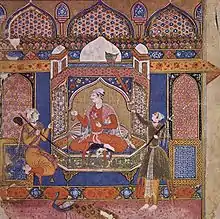 Raga Sri, Ragamala, 1590–1600
Raga Sri, Ragamala, 1590–1600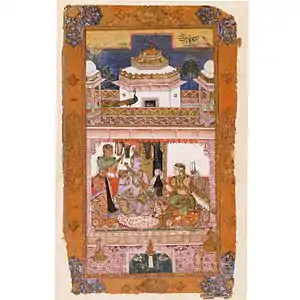 Bhairava raga, Ragamala, Chunar, 1591
Bhairava raga, Ragamala, Chunar, 1591 Todi Ragini, Ragamala, Bundi, Rajasthan, 1591
Todi Ragini, Ragamala, Bundi, Rajasthan, 1591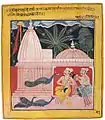 Sarang ragini, Ragamala, ca1605
Sarang ragini, Ragamala, ca1605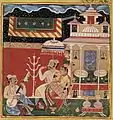 Raag Deepak, in Ragamala by Sahibdin 1605
Raag Deepak, in Ragamala by Sahibdin 1605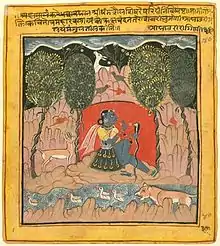 Asavari Ragini, Ragamala, 1610
Asavari Ragini, Ragamala, 1610 Malasri Ragini, Ragamala, Rajasthan. 1620
Malasri Ragini, Ragamala, Rajasthan. 1620 Pancham Ragini, Ragamala, 1680–1690
Pancham Ragini, Ragamala, 1680–1690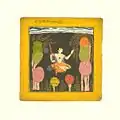 Goda raga, Ragamala, ca 1710
Goda raga, Ragamala, ca 1710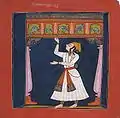 Kuntala Raga, 'son' of Dipakeda Raga, Ragamala, 1710
Kuntala Raga, 'son' of Dipakeda Raga, Ragamala, 1710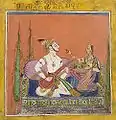 Ragaputra Velavala of Bhairava. 1710
Ragaputra Velavala of Bhairava. 1710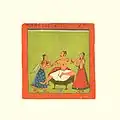 Alhaiya raga, Son of Bhairava Raga, Ragamala, c1720
Alhaiya raga, Son of Bhairava Raga, Ragamala, c1720 Varari ragini, Ragamala, 17th century
Varari ragini, Ragamala, 17th century Hindola Raga, Ragamala, 17th century
Hindola Raga, Ragamala, 17th century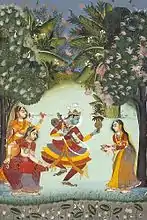 Vasant Ragini, Ragamala, Rajput, 1770
Vasant Ragini, Ragamala, Rajput, 1770 Radha-Krishna, a depiction of Bhairava Raga, Ragamala. ca 1770
Radha-Krishna, a depiction of Bhairava Raga, Ragamala. ca 1770 Raga Sri recital to Krishna-Radha, 19th century
Raga Sri recital to Krishna-Radha, 19th century Dipaka Raga
Dipaka Raga Kamodani Ragini
Kamodani Ragini Dhanyashri Ragini
Dhanyashri Ragini Malkosa Raga
Malkosa Raga
References
- Ragamala Art Gallery of New South Wales.
- "Ragamala Paintings".
- Ragamala - wyastone.co.uk. Archived 26 May 2008 at the Wayback Machine
- Bhairavi Ragini - britishmuseum.org.
- "Bernoulli,* Daniel - Dictionary definition of Bernoulli,* Daniel - Encyclopedia.com: FREE online dictionary".
- Ragamala Britannica.com.
Further reading
- Moghul Ragamala: Painted Indian Melodies and the Poetry of Kshemakarna, by Ludwig V. Habighorst. Koblenz: Ragaputra Edition, 2006.
- Ragamala Paintings from India, the collection of Claudio Moscatelli, by Glynn, Skelton, Dallapiccola. Philip Wilson Publishers in association with Dulwich Picture Gallery Museum and Art Gallery London 2011
External links
| Wikimedia Commons has media related to Ragamala. |
